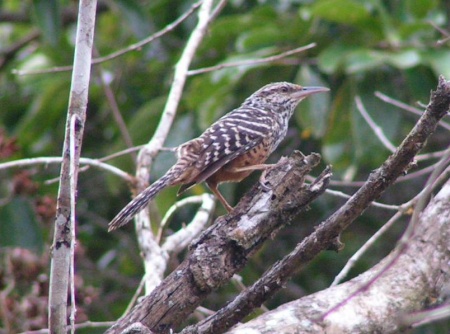- Campylorhynchus zonatus
Identification
16.5 cm
- Brown-grey crown
- Black nape
- Upperparts and tail with heavy barring in black, tawny and white
- White breast and throat, heavy black spots
- Cinnamon belly
Young birds have duller upperparts and off-white to buff underparts.
Distribution
Mexico to northwestern Ecuador, Costa Rica, northern Panama, northern Colombia adjacent to Panama, and northwestern Ecuador.
Taxonomy
Subspecies
There are 7 subspecies[1]:
- C. z. zonatus:
- Eastern Mexico (eastern San Luis Potosí and northern Veracruz to northern Puebla)
- C. z. restrictus:
- C. z. vulcanius:
- C. z. costaricensis:
- Caribbean slope of Costa Rica and north-western Panama
- C. z. panamensis:
- Western Panama (Veraguas)
- C. z. curvirostris:
- Northern Colombia (tropical base of Santa Marta Mountains)
- C. z. brevirostris:
An eigth subspecies imparilis[2] is not recognised by all authorities
Habitat
Lowlands and foothills in thinned forest or open woodland, scrub, second growth and around houses.
Behaviour
Breeding
It builds a large spherical nest with a wide side entrance, often hidden amidst bromeliads. The three to five white eggs (either unmarked or with light brown spots) are incubated by the female for about two weeks. After breeding, families sleep together in dormitory nests throughout the year.
Diet
The diet includes insects, spiders and invertebrates.
References
- Clements, JF. 2011. The Clements Checklist of Birds of the World. 6th ed., with updates to August 2011. Ithaca: Cornell Univ. Press. ISBN 978-0801445019. Spreadsheet available at http://www.birds.cornell.edu/clementschecklist/downloadable-clements-checklist
- Avibase
- Wikipedia
Recommended Citation
- BirdForum Opus contributors. (2025) Band-backed Wren. In: BirdForum, the forum for wild birds and birding. Retrieved 9 May 2025 from https://www.birdforum.net/opus/Band-backed_Wren
External Links
GSearch checked for 2020 platform.




